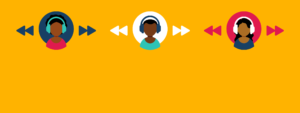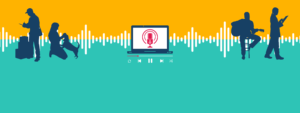Here in April, as the second quarter lurches forward, it’s supposed to be Spring in my Pacific Northwest home, even as I stare out the window desperately hoping for a glimpse of blue sky and sun. Nevertheless, despite a dark and dreary winter for many of us in the northern hemisphere, looking back at the last quarter I see several – four, to be precise – bright signs for podcasting in the months ahead.
1. The Podcast Audience Is Growing, and in the Right Ways
To mangle an old adage, if you host a podcast in the forest with nobody to hear it (and, no microphones, I guess) does it even exist? So it goes that one of the most important ingredients of podcasting is audience. And for the medium as a whole, this year’s audience is bigger than ever before.
Every March the industry sits on the edge of its office chairs waiting for the big number from Edison Research’s Infinite Dial. After a minor downturn in 2022, this year’s report offered relief, showing that 42% of US residents aged 12+ (120 million) have listened to a podcast in the last month – an all-time high. The weekly podcast audience grew, too, now comprising 31% of the country, or 89 million people.
Zooming in on that weekly listenership, we just learned that now half of all 18 to 34 year-olds listened to a podcast in the last week. That data comes from Sounds Profitable’s “The Medium Moves the Message” – research we at Signal Hill partnered on – which also came out in March. This number nips at the heels of TV (at 54%) and AM/FM radio (59%), showing that not only is the podcast audience growing, but its growing in the right way. That’s not just because this is a valuable demographic for advertisers, but also because young adults are establishing the podcast habit, which bodes well for future listening.
2. Brands are Buying
Although I know plenty of ad buyers who got interested in podcasts because they were fans first, they stick with the channel because they can reach a great audience (see #1). It seems logical that audience growth would naturally result in more ad buying. Now, we’ll need to wait for the annual IAB/PwC revenue report in May for an official count, but signs from the first quarter point in a positive direction.
Way back in January, Campaign sounded a note of confidence from media buyers, despite a major shakeup in Spotify’s podcast business that included the high profile departure of chief content and ad business officer Dawn Ostroff. They, “aren’t concerned about Spotify’s commitment to its ads or podcasting businesses.”
Bob Hunt, Hearts & Science senior director of audio, told Campaign, “[t]he percentage of revenue at Spotify that comes from advertising has increased in recent years, and we expect that to continue going forward.”
Digiday played a similar tune at the beginning of February with the news that “podcast ad buyers have yet to see notable budget cuts from their clients… they are continuing to see an increase in brands’ podcast ad spend.”
According to Kristen Coseo, director of podcast and digital audio strategy at Ocean Media, clients are pulling back from other channels and reallocating to podcasts. “Right now, podcasts have just been — on a performance standpoint — killing it for all clients,” she said.
Digiday recently followed up with an optimistic coda, reporting that more traditional brands, like Molson Coors and Sleep Number are investing, while, “The Weather Channel ran a podcast ad campaign on Pandora last summer, which drove a 6% lift in overall brand favorability.”
3. Buzz about YouTube
When I attended Hot Pod Summit in February, YouTube created the biggest buzz, announcing new podcast features in its video product, along with plans to add podcasts to YouTube Music. While there are many thoughtful skeptics in the community, I’m hearing more excited optimism than I might have anticipated.
We see this in recent announcements that Freakonomics Radio and Slate are each bringing their podcast rosters to YouTube. Both are veteran publishers that have weathered multiple hype cycles in the industry, which prompts me to take their moves seriously.
The simple fact of Google’s expanded podcast investment at this moment is a bright sign. There is much yet to be seen and worked out, but the opportunity to invite new audiences appears potentially ripe.
4. Opportunities Abound
Talking to the New York Times in February, Magnificient Noise’s Eric Nuzum said, “the dumb money era is over.” Then, speaking at Radio Days Europe in March, he offered a follow-up argument I fully endorse:
“Market saturation is real for some, but only an issue for those who are satisfied with creating mediocre podcasts. Those who settle for ‘okay.’ Those satisfied with making things that are the same as everyone else. Those satisfied to create things that are only marginally different.”
I’ll add that the “okay” and “mediocre” are not what brings new listeners into the fold, and yet those listeners are flowing in. The impressive range of nominees and winners at this year’s Ambies and iHeart Podcast Awards shows there’s no shortage of fresh, interesting and innovative shows that would not exist if producers just said, “forget it, the market’s saturated.”
And, still, we have 58% of the US that hasn’t listened to a podcast in the last month. Welcoming in 1% – or even .001% – more is a fantastic opportunity for any ambitious podcaster.
Going back to that February Times piece, it closed with another quote from Nuzum: “If the audience is there, that’s the real sign of health… The business will figure it out.” Given that the podcast audience is there – and growing – and that ad buyers are buying, the facts on the ground show that the business is, indeed, figuring it out.




